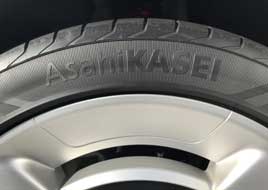Following its announcement last year to begin producing and marketing sustainable solution-polymerised styrene-butadiene rubber (S-SBR) using the sustainable butadiene at its plant in Singapore by the end of fiscal 2021, Asahi Kasei has developed a system1 to calculate the carbon footprint of products (CFP2) for its synthetic rubber and elastomers products marketed as Asadene, Tufdene, Asaprene, Tufprene, Asaflex, Tuftec, and S.O.E. with CFP data provision to customers scheduled to begin in June 2022. CFP visualisation is achieved utilising the DEEP (Data Exploration and Exchange Pipeline) group-wide management infrastructure as a part of the system, which also enables examination of ways to further reduce CFP.
It adds that it has made efforts to strengthen the business platform for sustainable growth from the viewpoint of Green, Digital, and People in its previous medium-term management plan, Cs+ for Tomorrow 2021.
In its new medium-term management plan, announced in April, Green Transformation is positioned as one of the key areas for strengthening the management foundation, and Asahi Kasei is advancing reductions of its own GHG emissions as well as contributions to reducing the world’s GHG emissions for the realisation of carbon neutrality. Therefore, from the perspective of GHG emissions reduction, Asahi Kasei has sequentially advanced the calculation of CFP for each product starting with the main products, and information provision to certain customers has begun.
As part of the effort to accelerate Green Transformation, Asahi Kasei has begun procuring butadiene derived from plastic waste and biomass as feedstock for S-SBR, a material for eco-friendly tyres. Asahi Kasei concluded an agreement with Shell Eastern Petroleum last year regarding the supply of butadiene derived from plastic waste and biomass. At that time it stated it will be the world’s first company to use butadiene derived from plastic waste, and the first Japanese company to use butadiene derived from biomass, for S-SBR production (according to internal research)
The system clarifies the CFP for each synthetic rubber and elastomer product, which allows customers to calculate their own CFP. This furthermore facilitates initiatives to reduce CFP throughout the supply chain as well as in society as a whole. As various regulations related to CFP such as carbon taxes are introduced, CFP data will continue to rise in importance.
The system also allows various parameters of the CFP data such as span (yearly or monthly) and scope (average of products or each product individually) to be tailored to meet the diverse needs of customers. In addition to using the system to visualise CFP, Asahi Kasei will continue to proactively strive toward the carbon neutrality of its synthetic rubber and elastomer products, including the use of sustainable feedstocks and green electricity, and efforts to obtain ISCC certification.
1 For the CFP calculation by the system, the Life Cycle Inventory (LCI) database of “IDEAv2.3”, Inventory Database for Environmental Analysis, provided by Sustainable Management Promotion Organisation (SuMPO), and the emissions intensity database provided by the Japanese Ministry of the Environment are used. Data sources are scheduled to be extended.
2 CFP is quantitatively calculated by combining the total GHG emissions from the entire life cycle of products and services, from raw material procurement to disposal and recycling, and then converting the figure into the equivalent amount of CO2. Asahi Kasei’s CFP calculation is based on “Cradle-to-Gate” assessment, which combines upstream emissions of materials and transportation, emissions from in-house manufacturing processes, and energy-related emissions such as electricity used during manufacturing.

